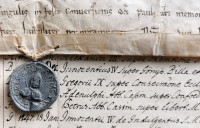The Restauration of Two Leaden Seal from Monte Cassino
In the Pannonhalma letters-patent, Saint Stephen granted the licences of Montre Cassino – Saint Benedict’s abbey in Italy – to the first monastery in Hungary. Due to this, in the past millennium, a manifold relationship was formed between the two monastic communities whose two important documents are a charter of 1180 and another one of 1212. The first document issued by Peter, the Abbot of Cassino recorded the Italian journey of a monk from the community of Abbot Similis of Pannonhalma. First, he went to Rome to make Pope Alexander III draw up a letters-patent in connection with the unity of title between the Italian and Hungarian abbeys. Hereupon he visited Monte Cassino to make a copy of the documents about the privileges of the monastery there. In the archives of Monte Cassino, the researcher-delegate of Pannonhalma also put down on parchment some miracles that took place at the tombs of Saint Benedict and Saint Scholastica. The second document can be related to the first Italian journey made by Abbot Uros of Saint Martin. It was then that the two monasteries established a mutual prayer union: Abbot Adenulfus issued a charter for Abbot Uros and his monastic community, in this document he asked them to pray for the community in Cassino as they do in Cassino annually on the feast of Saint Paul’s conversion (25 January) having a solemn divine service for the monks of Pannonhalma. Abbot Uros brought home this document, and the monks of Monte Cassino made a note of it related to the given date in their Necrologium that they have to remember their brethren of Pannonhalma in their prayers on that day. Owing to this prayer union, the two communities have already prayed for each other on that day for 811 years. The leaden steals of these two documents in the possession of the Pannonhalma Archabbey Archives became infected during an exhibition some years ago. After laboratory examinations, the bullas were cleansed and furbished by Balázs Lukács restorer artist in the workshop of the Hungarian National Museum. The work’s expenses were partially provided by the National Cultural Fund of Hungary.
